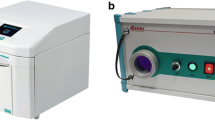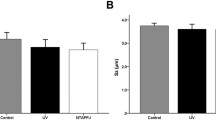Abstract
The purpose of this study was to evaluate blood and platelet response to nanostructured TiO2 coatings and to investigate the effect of Ultraviolet (UV) light treatment on blood clotting ability, platelet activation and protein adhesion. Ti-6Al-4V titanium alloy plates (n = 138) were divided into three groups; a sol–gel derived MetAliveTM coating (MA); hydrothermal coating (HT); and a non-coated group (NC). Sixty nine titanium substrates were further treated with UV light for 1 h. The thrombogenicity of the titanium substrates was assessed using fresh human blood with a whole blood kinetic clotting time method. The platelet adhesion test was conducted to evaluate the morphology and adhesion behavior of the platelets on the titanium substrates. Human diluted plasma and bovine fibronectin were used to evaluate protein adsorption. Total clotting time for the UV treated HT, MA and NC titanium substrates was almost 40 min compared to 60 min for non-UV substrates, the total clotting time for the UV treated groups were significantly lower than that of the non UV NC group (p < 0.05). UV light treatment had significantly enhanced coagulation rates. The HT and MA substrates presented more platelet aggregation, spreading and pseudopod formation in comparison with the NC substrates. UV treatment did not affect the platelet activation and protein adsorption. This in vitro study concluded that nanostructured titanium dioxide implant surfaces obtained by sol–gel and hydrothermal coating methods increased coagulation rates and enhanced platelet response when compared with non-coated surfaces. UV light treatment clearly improved thrombogenicity of all examined Ti-6Al-4V surfaces.







Similar content being viewed by others
References
Di Iorio D, Traini T, Degidi M, Caputi S, Neugebauer J, Piattelli A. Quantitative evaluation of the fibrin clot extension on different implant surfaces: an in vitro study. J Biomed Mater Res B Appl Biomater. 2005;74:636–42.
Park JY, Davies JE. Red blood cell and platelet interactions with titanium implant surfaces. Clin Oral Implants Res. 2000;11:530–9.
Thor A, Rasmusson L, Wennerberg A, et al. The role of whole blood in thrombin generation in contact with various titanium surfaces. Biomaterials. 2007;28:966–74.
Hong J, Andersson J, Ekdahl KN, et al. Titanium is a highly thrombogenic biomaterial: possible implications for osteogenesis. Thromb Haemost. 1999;82:58–64.
Drinker CK, Drinker KR, Lund CC. The circulation in the mammalian bone-marrow. Am J Physiol-Leg Content. 1922;62:1–92.
Davies JE. Mechanisms of endosseous integration. Int J Prosthodont. 1998;11:391–401.
Niinomi M, Nakai M, Hieda J. Development of new metallic alloys for biomedical applications. Acta Biomater. 2012;8:3888–903.
Liu X, Chu PK, Ding C. Surface modification of titanium, titanium alloys, and related materials for biomedical applications. Mater Sci Eng: R: Rep. 2004;47:49–121.
Ellingsen JE. A study on the mechanism of protein adsorption to TiO2. Biomaterials. 1991;12:593–6.
Klinger A, Steinberg D, Kohavi D, Sela MN. Mechanism of adsorption of human albumin to titanium in vitro. J Biomed Mater Res. 1997;36:387–92.
Steinberg D, Klinger A, Kohavi D, Sela MN. Adsorption of human salivary proteins to titanium powder. I. Adsorption of human salivary albumin. Biomaterials. 1995;16:1339–43.
Tomsia AP, Lee JS, Wegst UG, Saiz E. Nanotechnology for dental implants. Int J Oral Maxillofac Implants. 2013;28:e535–46.
Kubo K, Tsukimura N, Iwasa F, et al. Cellular behavior on TiO2 nanonodular structures in a micro-to-nanoscale hierarchy model. Biomaterials. 2009;30:5319–29.
Jimbo R, Sawase T, Baba K, Kurogi T, Shibata Y, Atsuta M. Enhanced initial cell responses to chemically modified anodized titanium. Clin Implant Dent Relat Res. 2008;10:55–61.
Peltola T, Patsi M, Rahiala H, Kangasniemi I, Yli-Urpo A. Calcium phosphate induction by sol-gel-derived titania coatings on titanium substrates in vitro. J Biomed Mater Res. 1998;41:504–10.
Kim HM, Miyaji F, Kokubo T, Nakamura T. Preparation of bioactive Ti and its alloys via simple chemical surface treatment. J Biomed Mater Res. 1996;32:409–17.
Zuldesmi M, Waki A, Kuroda K, Okido M. Hydrothermal treatment of titanium alloys for the enhancement of osteoconductivity. Mater Sci Eng C Mater Biol Appl. 2015;49:430–5.
Hoshi N, Negishi H, Okada S, Nonami T, Kimoto K. Response of human fibroblasts to implant surface coated with titanium dioxide photocatalytic films. J Prosthodont Res. 2010;54:185–91.
Werner S, Huck O, Frisch B, Vautier D, Elkaim R, Voegel JC, Brunel G, Tenenbaum H. The effect of microstructured surfaces and laminin-derived peptide coatings on soft tissue interactions with titanium dental implants. Biomaterials. 2009;30:2291–301.
Botos S, Yousef H, Zweig B, Flinton R, Weiner S. The effects of laser microtexturing of the dental implant collar on crestal bone levels and peri-implant health. Int J Oral Maxillofac Implants. 2011;26:492–8.
Frojd V, Linderback P, Wennerberg A, Chavez de Paz L, Svensater G, Davies JR. Effect of nanoporous TiO2 coating and anodized Ca2+ modification of titanium surfaces on early microbial biofilm formation. BMC Oral Health. 2011;11:8–6831-11-8.
Schupbach P, Glauser R. The defense architecture of the human periimplant mucosa: A histological study. J Prosthet Dent. 2007;97:S15–25.
Welander M, Abrahamsson I, Berglundh T. The mucosal barrier at implant abutments of different materials. Clin Oral Implants Res. 2008;19:635–41.
Zreiqat H, Howlett CR. Titanium substrata composition influences osteoblastic phenotype: in vitro study. J Biomed Mater Res. 1999;47:360–6.
Kasemo B. Biocompatibility of titanium implants: surface science aspects. J Prosthet Dent. 1983;49:832–7.
Gittens RA, Scheideler L, Rupp F, et al. A review on the wettability of dental implant surfaces II: Biological and clinical aspects. Acta Biomater. 2014;10:2907–18.
Kohavi D, Badihi Hauslich L, Rosen G, Steinberg D, Sela MN. Wettability versus electrostatic forces in fibronectin and albumin adsorption to titanium surfaces. Clin Oral Impl Res. 2013;24:1002–8.
Eriksson C, Nygren H, Ohlson K. Implantation of hydrophilic and hydrophobic titanium discs in rat tibia: cellular reactions on the surfaces during the first 3 weeks in bone. Biomaterials. 2004;25:4759–66.
Bornstein MM, Valderrama P, Jones AA, Wilson TG, Seibl R, Cochran DL. Bone apposition around two different sandblasted and acid-etched titanium implant surfaces: a histomorphometric study in canine mandibles. Clin Oral Implants Res. 2008;19:233–41.
Wilson CJ, Clegg RE, Leavesley DI, Pearcy MJ. Mediation of biomaterial-cell interactions by adsorbed proteins: A review. Tissue Eng. 2005;11:1–18.
Guida L, Oliva A, Basile MA, Giordano M, Nastri L, Annunziata M. Human gingival fibroblast functions are stimulated by oxidized nano-structured titanium surfaces. J Dent. 2013;41:900–7.
Areva S, Peltola T, Säilynoja E, Laajalehto K, Lindén M, Rosenholm JB. Effect of albumin and fibrinogen on calcium phosphate formation on sol−gel-derived titania coatings in vitro. Chem Mater. 2002;14:1614–21.
Meretoja VV, Rossi S, Peltola T, Pelliniemi LJ, Narhi TO. Adhesion and proliferation of human fibroblasts on sol-gel coated titania. J Biomed Mater Res A. 2010;95:269–75.
Hashimoto K, Irie H, Fujishima A. TiO2 photocatalysis: a historical overview and future prospects. Jpn J Appl Phys 1. 2005;44:8269–85.
Riley D, Bavastrello V, Covani U, Barone A, Nicolini C. An in vitro study of the sterilization of titanium dental implants using low intensity UV-radiation. Dent Mater. 2005;21:756–60.
Unosson E, Persson C, Welch K, Engqvist H. Photocatalytic activity of low temperature oxidized Ti-6Al-4V. J Mater Sci: Mater Med. 2012;23:1173–80.
Fujishima A, Zhang X, Tryk DA. TiO2 photocatalysis and related surface phenomena. Surf Sci Rep. 2008;63:515–82.
Suketa N, Sawase T, Kitaura H, et al. An antibacterial surface on dental implants, based on the photocatalytic bactericidal effect. Clin Implant Dent Relat Res. 2005;7:105–11.
Aita H, Hori N, Takeuchi M. et al. The effect of ultraviolet functionalization of titanium on integration with bone. Biomaterials. 2009;30:1015–25.
Aita H, Att W, Ueno T, et al. Ultraviolet light-mediated photofunctionalization of titanium to promote human mesenchymal stem cell migration, attachment, proliferation and differentiation. Acta Biomater. 2009;5:3247–57.
Hori N, Ueno T, Suzuki T, et al. Ultraviolet light treatment for the restoration of age-related degradation of titanium bioactivity. Int J Oral Maxillofac Implants. 2010;25:49–62.
Ogawa T. Ultraviolet photofunctionalization of titanium implants. Int J Oral Maxillofac Implants. 2014;29:e95–102.
Wu J, Zhou L, Ding X, Gao Y, Liu X. Biological effect of ultraviolet photocatalysis on nanoscale titanium with a focus on physicochemical mechanism. Langmuir. 2015;31:10037–46.
Yamada Y, Yamada M, Ueda T, Sakurai K. Reduction of biofilm formation on titanium surface with ultraviolet-C pre-irradiation. J Biomater Appl. 2014;29:161–71.
Jokinen M, Patsi M, Rahiala H, Peltola T, Ritala M, Rosenholm JB. Influence of sol and surface properties on in vitro bioactivity of sol-gel-derived TiO2 and TiO2-SiO2 films deposited by dip-coating method. J Biomed Mater Res. 1998;42:295–302.
de Jong HP, van Pelt AW, Arends J. Contact angle measurements on human enamel - an in vitro study of influence of pellicle and storage period. J Dent Res. 1982;61:11–3.
Huang N, Yang P, Leng YX, et al. Hemocompatibility of titanium oxide films. Biomaterials. 2003;24:2177–87.
Imai Y, Nose Y. A new method for evalution of antithrombogenicity of materials. J Biomed Mater Res. 1972;6:165–72.
Tanner J, Carlen A, Soderling E, Vallittu PK. Adsorption of parotid saliva proteins and adhesion of streptococcus mutans ATCC 21752 to dental fiber-reinforced composites. J Biomed Mater Res B Appl Biomater. 2003;66:391–8.
Park JY, Gemmell CH, Davies JE. Platelet interactions with titanium: modulation of platelet activity by surface topography. Biomaterials. 2001;22:2671–82.
Sharma CP. Surface--interface energy contributions to blood compatibility. Biomater Med Devices Artif Organs. 1984;12:197–213.
Zhao G, Schwartz Z, Wieland M, et al. High surface energy enhances cell response to titanium substrate microstructure. J Biomed Mater Res A. 2005;74:49–58.
Wang R, Hashimoto K, Fujishima A. Light-induced amphiphilic surfaces. Nature. 1997;388:431–2.
Iwasa F, Hori N, Ueno T, Minamikawa H, Yamada M, Ogawa T. Enhancement of osteoblast adhesion to UV-photofunctionalized titanium via an electrostatic mechanism. Biomaterials. 2010;31:2717–27.
Hori N, Ueno T, Minamikawa H, et al. Electrostatic control of protein adsorption on UV-photofunctionalized titanium. Acta Biomater. 2010;6:4175–80.
Wennerberg A, Albrektsson T. On implant surfaces: A review of current knowledge and opinions. Int J Oral Maxillofac Implants. 2010;25:63–74.
Goodman SL, Lelah MD, Lambrecht LK, Cooper SL, Albrecht RM. In vitro vs. ex vivo platelet deposition on polymer surfaces. Scan Electron Microsc. 1984;1:279–90.
Nygren H, Tengvall P, Lundstrom I. The initial reactions of TiO2 with blood. J Biomed Mater Res. 1997;34:487–92.
Chen J, Yang P, Liao Y, et al. Effect of the duration of UV irradiation on the anticoagulant properties of titanium dioxide films. ACS Appl Mater Interfaces. 2015;7:4423–32.
Acknowledgements
The authors gratefully acknowledge Ms. Katja Sampalahti, and Ms. Oona Hällfors (Institute of Dentistry, University of Turku) for their skillful technical assistance. The corresponding author wishes to thank the Libyan Ministry of Education for its scholarship support. This study was supported by ITI Grant no: 1256_2017
Author information
Authors and Affiliations
Corresponding author
Ethics declarations
Conflict of interest
The authors declare that they have no conflicts of interest with respect to the authorship and/or publication of this article.
Electronic supplementary material
Rights and permissions
About this article
Cite this article
Areid, N., Kangasniemi, I., Söderling, E. et al. Ultraviolet photofunctionalization of nanostructured titanium surfaces enhances thrombogenicity and platelet response. J Mater Sci: Mater Med 29, 56 (2018). https://doi.org/10.1007/s10856-018-6067-z
Received:
Accepted:
Published:
DOI: https://doi.org/10.1007/s10856-018-6067-z




